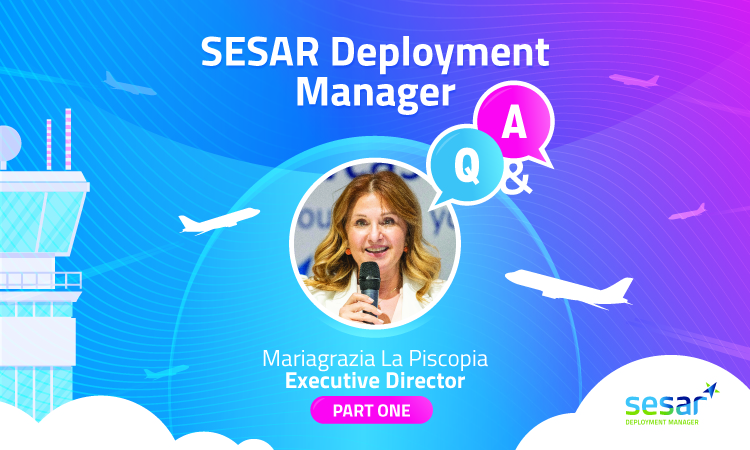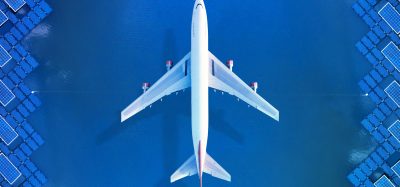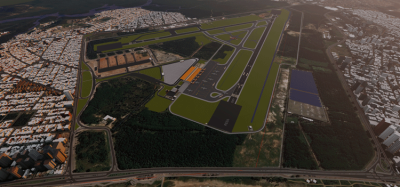The highway to the digital sky: A deep-dive into the SESAR project part 1
- Like
- Digg
- Del
- Tumblr
- VKontakte
- Buffer
- Love This
- Odnoklassniki
- Meneame
- Blogger
- Amazon
- Yahoo Mail
- Gmail
- AOL
- Newsvine
- HackerNews
- Evernote
- MySpace
- Mail.ru
- Viadeo
- Line
- Comments
- Yummly
- SMS
- Viber
- Telegram
- Subscribe
- Skype
- Facebook Messenger
- Kakao
- LiveJournal
- Yammer
- Edgar
- Fintel
- Mix
- Instapaper
- Copy Link
Posted: 10 May 2023 | Mariagrazia La Piscopia | No comments yet
Executive Director of SESAR Deployment Manager (SESAR DM), Mariagrazia La Piscopia, talks exclusively to International Airport Review about the SESAR project. She discusses the importance of reducing flight emissions right now rather than wait for next generation aircraft and SAF.


Mariagrazia La Piscopia, talks exclusively about the SESAR project
Executive Director of SESAR Deployment Manager (SESAR DM), Mariagrazia La Piscopia, talks exclusively to International Airport Review about the SESAR project and how we can reduce flight emissions right now rather than wait for next generation aircraft and SAF. Catch part 2 next week!
How is the Single European Sky’s ATM Research project “SESAR” going? What are the latest updates?
Looking at things from the unique SESAR Deployment Manager (SDM) deployment-based perspective, SESAR is working well and we are making good progress towards our objectives.
As always, old and new challenges are still ahead of us, and there is still room to work better together and ensure air traffic management (ATM) modernisation goes on, and that ATM becomes more effective than ever.
The Common Project One (CP1) regulation and related SESAR Deployment Programme, which is what SDM is called to co-ordinate, is being implemented. There is strong support from the industry stakeholders and currently 85% are in compliance with the 2022 deadlines. The expectation is that by the end of the year 95-97% will be complying, which is something unprecedented for ATM-related Implementing Rules.
We also saw an overall acceleration of CP1 deployment in Europe in the last 12 months: we are now above 31% of the regulation into operational use across Europe. With major projects coming to an end, this year we saw the percentage of completion more than doubling, starting from the 13% completion rate we had at the beginning of 2022. And this progress has happened with five years still remaining from the 2027 regulation deadline.
In this framework, it is essential that SESAR deployment continues, so that the ATM sector can use technology to deal with the major challenges of the future:
- Sustainability: We must cut all unnecessary emissions and help the industry to move towards decarbonisation in the shortest possible timeframe
- Capacity: We must make sure that passengers and airlines movements are accommodated in our skies, without delays and disruptions
- Digitalisation: We must leverage new technologies to make sure that the ATM industry, its systems, and infrastructure are fit for the next decades.
How is the project working to make our skies more sustainable and help save trees and fuel?
We need to make sure ATM can play its part in supporting the objectives of the European Green Deal, and – as co-ordinator of CP1 deployment – we have already been playing a critical role in this journey.
There is general consensus now in the European aviation industry on the fact that we cannot simply wait for the future solutions to come. Long-term solutions such as new-generation aircraft, the widespread use of sustainable aviation fuels, new engines, they all still require time before they are available, but we can already do our part with efficient ATM operations.
The flight of the future will be the one that does not produce emissions, but until that is possible, there is an ideal flight that we can build now: one where no unnecessary emissions are produced, where we allow airlines not to waste fuel, to fly the optimal flight between two airports, and to use the best flight profile they can. This ideal flight is in sight: we are talking years, not decades.
There are strategic and technical operational measures that can be taken to optimise the airspace and optimise routes, but a big game-changer is technology, particularly those coming from SESAR. From our side, we have co-ordinated initiatives that helped the industry become more sustainable and that will help to further reduce the carbon footprint.
Just some of the titles that CP1 helps deploy include: extended AMAN, departure management and airport operations plan, free route, advanced flexible use of airspace, etc.
A flight that benefits from these technologies is already – right now – much closer to the ideal flight than what could be imagined:
- Before departure, the flight saves time, fuel, and emissions because the aircraft does not spend any unnecessary time queuing, it leaves from its stand only when required and is less subject to disruption.
- When flying at cruise level, it can fly its preferred path (horizontally and vertically), and it already considers deviations due to temporary airspace closures
- When approaching a destination, the flight can adjust its speed, avoiding holdings and adopting optimal descent profiles
- When landing, it can count on the most fuel-efficient procedures, and rapidly arrive to its gate to ensure passengers can get off the plane in a timely manner.
A flight that counts on these technologies can save fuel throughout its whole path (taxi-out, cruise, arrival, taxi-in), for up to 600 kg of CO2 emissions (189 kg of fuel). If we look at the average excess fuel burn consumed by a flight today, this means that technologies from CP1 and co-ordinated by SDM alone can save up to around 60% of these excess emissions.
If you think of one of the best achievements in the sustainability area, which is the large-scale free route adoption in Europe, estimated to be 30% of the excess fuel burn during the cruise flight. This was possible because all stakeholders, along with us, with the Network Manager and the European Climate, Infrastructure and Environment Executive Agency (CINEA), did their part: FRA is available in Italy, Germany, UK, Spain, Poland, the whole Scandinavian Region (Norway, UK, Iceland, Sweden, Finland, Denmark, Estonia, Latvia) through Borealis, the Danube functional airspace block (FAB) and FAB Central Europe. All these implementations happened with SDM support and co-ordination.
Now the next target is full cross-border FRA, and it is already happening. Just last January, we submitted a new investment proposal that would bring cross-border almost everywhere: between Spain and Portugal, including the Oceanic region, between Italy, Malta, and the Balkans, even in most of Central and Eastern Europe. If we get through it, these projects alone will bring cross-border FRA into 60% of the European airspace, and if we consider what we already achieve, this means essentially 100% of Europe, and it will be available by 2025.
How will this project enable passengers to save time?
The 259 projects that we already put in operation are bringing many benefits to passengers, starting from savings of their time and an overall better experience for all travellers.
The benefits of the projects we coordinated are numerous. Not only will flights be shorter when airlines are able to fly more direct and efficient routes, but several of the investments carried out by ANSPs are expected to increase the airspace capacity, greatly reducing the expected delays of flights in Europe. That’s not all. With better planning of both airport and network operations, the number of disruptions and unexpected events is going to decrease significantly. This means less time spent by passengers in the aircraft waiting for departure, and more efficient operations throughout their journey.
How are you working with both civil and military organisations to deliver the project?
We strongly believe that results can only be achieved if all operational stakeholders work together towards the same goal at the same time. They are the true engine of ATM modernisation, and we are here to support them. This means both civil and military stakeholders.
Stakeholder commitment, buy-in and involvement: Without stakeholders implementing SESAR in real life and in their daily operations, there is no modernisation, no digitalisation, no way towards sustainability. As SDM, we are proud of having developed a framework that stakeholders trust, also thanks our unique consultation process which we launched since SDM inception.
Looking at the military dimension, we have the closest co-operation with the EDA (European Defence Agency), which allows us to keep the operational, military, and institutional dimensions all together when it comes to deployment.
Within our CP1 remit, we have already helped a lot of stakeholders (both civil and military) to make way for a flexible use of airspace and to ensure its management keeps both perspectives and needs together.
Some of the projects we helped deploy allowed for significant progress in places like Spain, Italy, France, Portugal, but also in countries which are now affected by the situation in Ukraine, like the those in the South-Central part of Europe, the Danube FAB, in Estonia, etc.
The adoption of airspace management tools allow both civil and military airspace users to achieve their goals in a co-operative manner. One of the latest examples is the traffic complexity assessment tool (TCAT) project in Bulgaria, which has already proven useful after the invasion of Ukraine: flow management positions (FMPs) and Air Traffic Control Officers (ATCOs) can assess the air traffic situation, its future evolution, and open/close sectors, enabling better traffic flows. In the current set-up, where operations are often subject to variations and unexpected constraints, this tool is critical to ensure a smooth management of traffic flows. I think we will need more of these systems in place, and the same constructive spirit that we have seen in the last months.


Mariagrazia is the Executive Director of the SESAR Deployment Manager (SDM).
The Single European Sky’s ATM Research project (SESAR) is one of the most ambitious modernisation projects launched by the European Union in the transport domain, contributing to the implementation of the Single European Sky.
The SDM is in charge of coordinating and synchronising the innovation of Europe’s Air Traffic Management infrastructure ensuring, the full involvement and responsibility of the ATM industry in the delivery of SESAR. The SDM function is operated by the SESAR Deployment and Infrastructure Partnership (SDIP), a consortium composed by Airlines,
Air Navigation Service Providers, Airports and EUROCONTROL. Mariagrazia has more than 20 years of experience in Aviation and Air Traffic Management at technical, operational and strategic level, spanning from R&D to Deployment.
As Executive Director she is responsible for the overall strategic vision and management of the activities performed by the SDM. Before being nominated as Executive Director, she covered the role of SDM Chief Strategy and Programme Management, in charge of planning, coordinating and executing the technical programmes.
Before the establishment of the SDM, she was the Head of International Coordination and ATM Planning in one of the major European Air Navigation Service Providers (ENAV S.p.A.), contributing to the enhancement of the company role and the improvement of its positioning at European level.
She has an extensive experience in technical and operational activities, with a wide know-how in many air traffic management areas, covering both the airport and the en-route dimension, from different aviation stakeholders’ perspective.
Related topics
Airport Collaborative Decision Making (A-CDM), Digital transformation, Emissions, Operational efficiency, Sustainability, Sustainable development

















